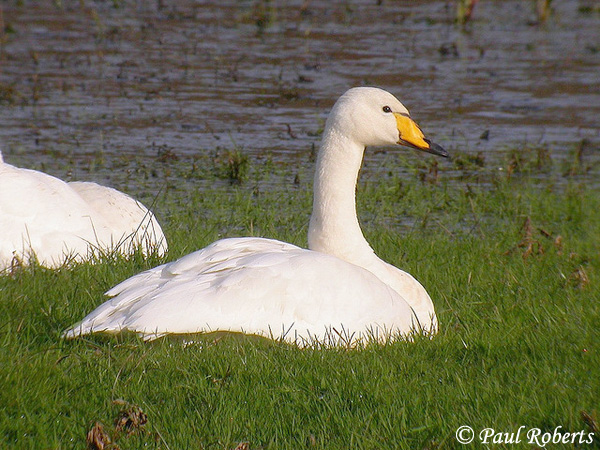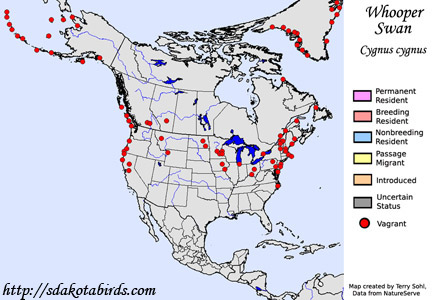Whooper Swan
Cygnus cygnus
| Length: 54 - 64 inches | Wingspan: 80 - 108 inches | Seasonality: Non-resident in South Dakota |
| ID Keys: Very large size, all white, mostly yellow bill with black end | ||
 The
Whooper Swan is often considered the Eurasian ecological equivalent to North
America's Trumpeter Swan. They once used to breed in eastern
Greenland, but are now considered only vagrants in North America.
Records have largely been of overwintering birds, with most sightings in
northeastern North America and Alaska. It is currently unclear whether
some sightings in North America are in fact captive escapees, although many
are undoubtedly of wild origin.
The
Whooper Swan is often considered the Eurasian ecological equivalent to North
America's Trumpeter Swan. They once used to breed in eastern
Greenland, but are now considered only vagrants in North America.
Records have largely been of overwintering birds, with most sightings in
northeastern North America and Alaska. It is currently unclear whether
some sightings in North America are in fact captive escapees, although many
are undoubtedly of wild origin.
Habitat: Breeding habitat is usually wetland habitat hear large freshwater lakes, usually with large amounts of herbaceous, emergent vegetation. They are also found in wetland habitats and large water bodies in migration and in winter, and will also utilize agricultural lands for foraging.
Diet: Predominantly vegetarian, feeding on roots, leaves, and stems of aquatic plants, as well as terrestrial grasses, sedges, roots, and tubers. On their breeding grounds, fledglings and young birds will also often eat aquatic and terrestrial insects and insect larvae. Adult Whooper Swans will sometimes supplement their diet with fresh and saltwater mollusks. In migration and during the winter months, waste grain and other vegetative material from agricultural fields may make up a large portion of the diet.
Nesting: Whooper Swans mate for life. Both parents will help to construct the nest, typically a large mound of vegetation found near the banks of a water body. The female alone incubates the eggs. Both parents will tend to the young after hatching, but the young quickly leave the nest and find their own food.
Song: A very deep, strong honking.
Migration: Whooper Swans breed in subarctic portions of Europe and Asia, and winter in northern Europe and eastern Asia.
Interactive eBird map: Click here to access an interactive eBird map of Whooper Swan sightings
Similar Species: Trumpeter Swan, Tundra Swan, Mute Swan
Conservation Status: There are no major threats to populations of the Whooper Swan, and the IUCN currently lists it as a species of "Least Concern".
Further Information: 1) Whatbird.com - Whooper Swan
2) BirdLife International - Whooper Swan
3) A Whooper Swan at Yellowstone National Park, Wyoming, with Comments on North American Reports of the Species - Terry McEneany - U.S. National Park Service
Photo Information: Photo taken by Paul Roberts - Ogmore Estuary, Glamorgan, October 2008 - Photo licensed through Creative Commons Attribution Non-Commercial 2.0 Generic License.
| Click below for a higher-resolution map |
 |
| South Dakota Status: Non-resident in South Dakota |
Additional Whooper Swan Photos (coming soon!!)
